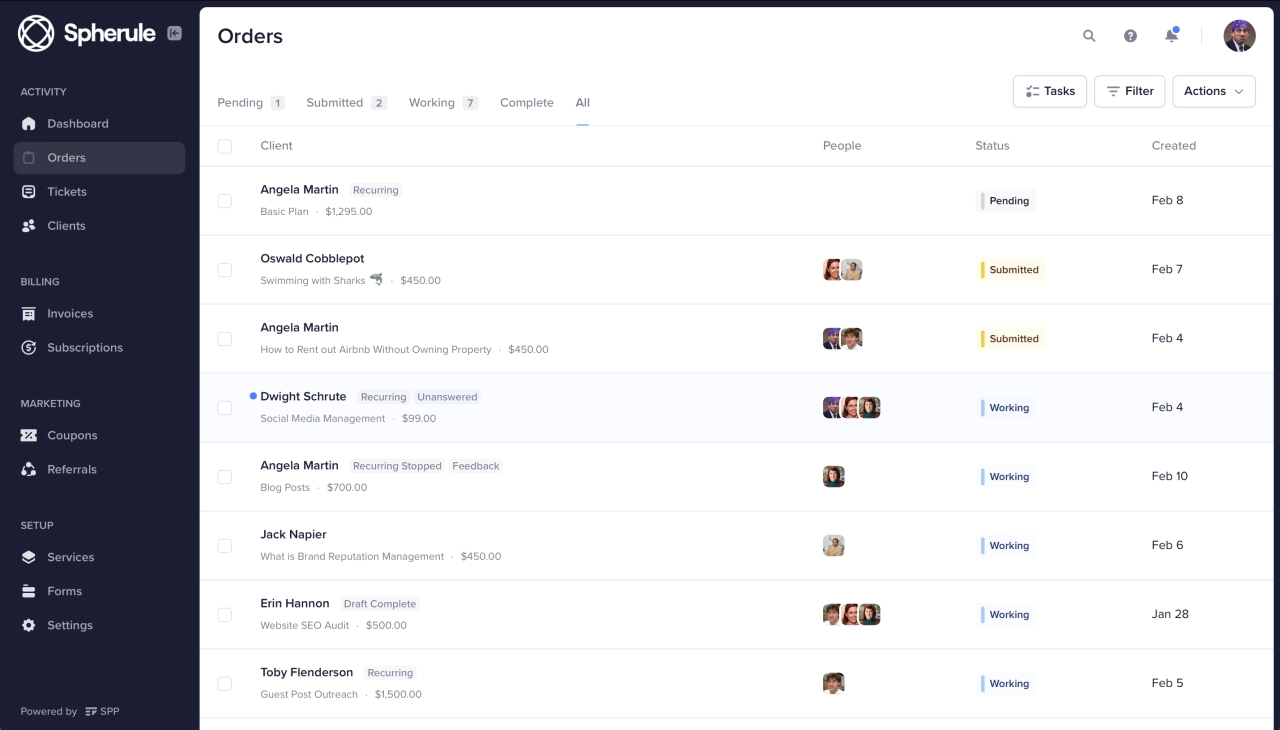If you’re only focused on bringing in new customers as the most important task in your business, you might be missing out on easier and cheaper ways to grow. Many company owners are unaware of the fact that it can cost up to five times more to get a new client than to build a long-lasting relationship with existing customers.
In other words, you could invest a fraction of your client acquisition budget into client management activities and get a better result in the end.
At SPP, we know how important it is to keep clients around, which is why we put a lot of effort into good client management, which includes customer support, listening to feedback, and building new features.
Effective client management can reduce the need to spend big amounts on lead generation. After all, it might be easier to upsell existing customers than convincing potential clients of your services.
Let’s take a closer look at how you can build client relationships that last for years.
What is client management?
Client Management is the practice of effectively managing relationships with clients to achieve mutually beneficial outcomes. It involves building trust, understanding client needs, and delivering high-quality work that exceeds expectations. This approach enables agencies to foster long-term partnerships, increase customer loyalty, and drive business growth.
Effective client management involves:
regular communication and feedback
proactive issue resolution
tailored solutions based on client needs
transparent billing and project management
The importance of client management
Client management is defined by processes which have the scope to manage and nurture customers, their expectations, and needs. The idea is that the company learns as much as it can about their clients, so it can better serve them. The longer the relationship between both parties lasts, the more data can be gathered, increasing the success rate of the relationship management.
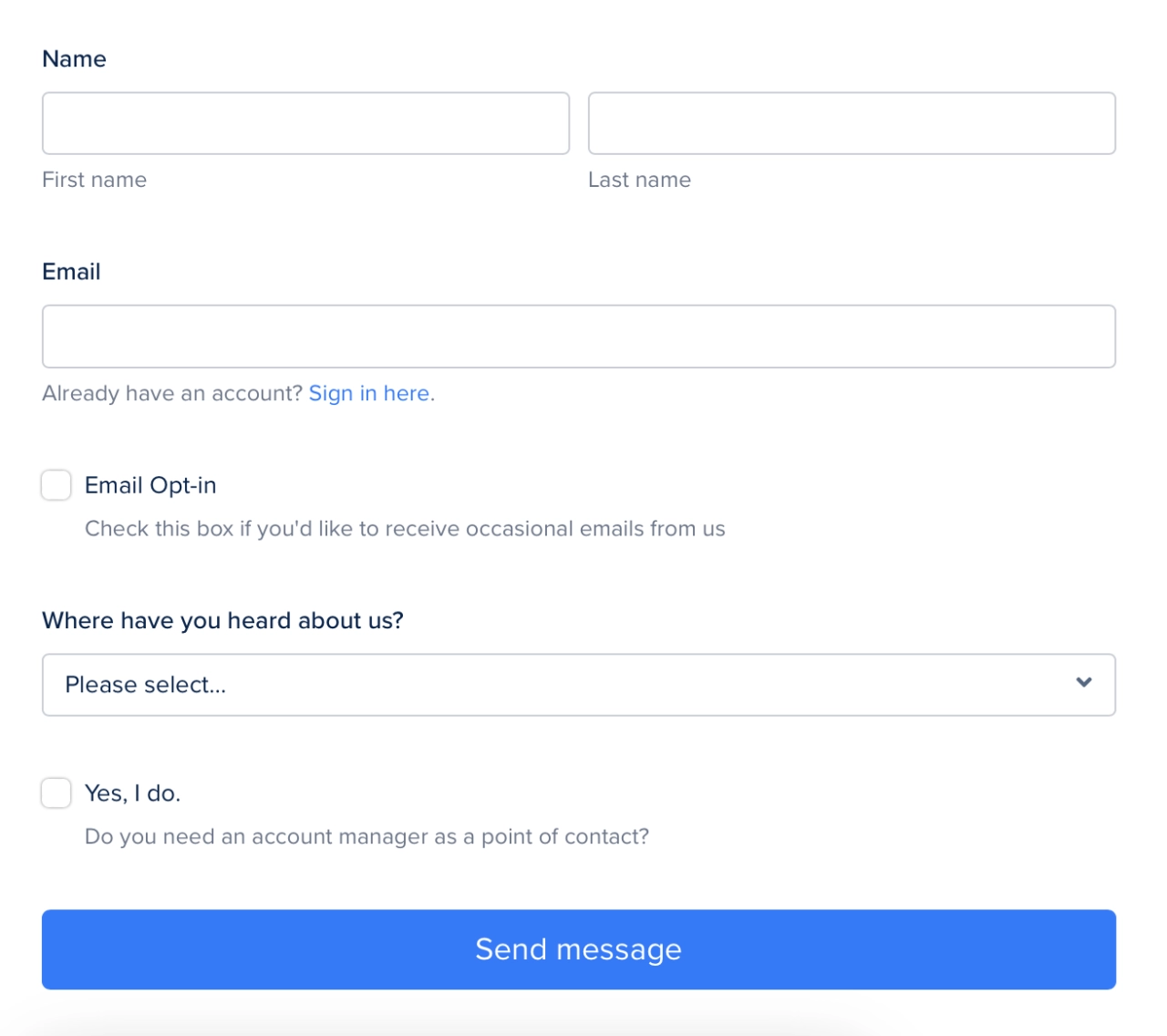
Depending on the business activities and lead generation, companies often try to learn as much as it can about its new client from the get-go, for instance through lead generation forms that ask questions, such as:
Where have you heard about us?
What are the services you’re most interested in?
What is your monthly spending budget?
Besides the voluntary user input, a company can also gather information about the product or service a customer purchases, and save that information in a dedicated app, usually a customer management relationship system.
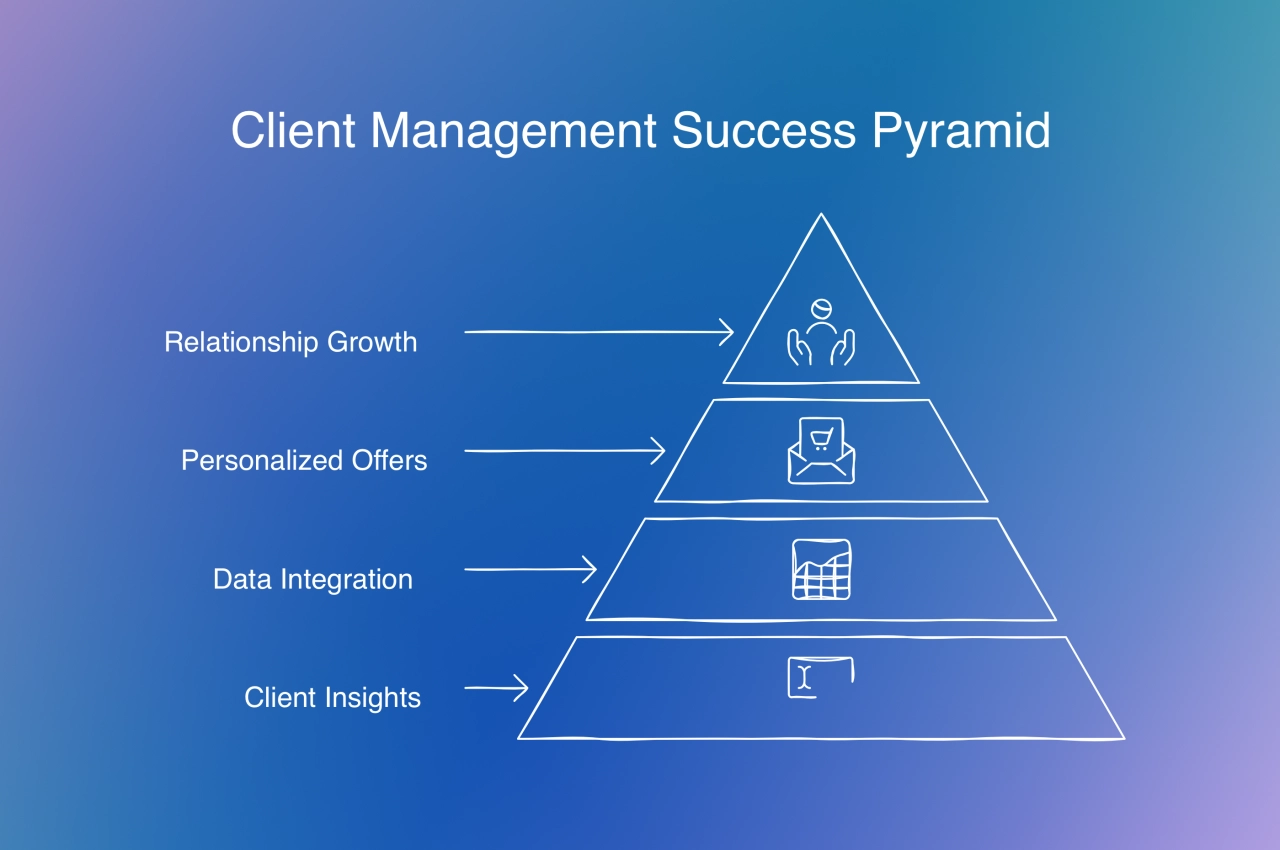
In return, this information can be used to make decisions, such as when to offer discounts, or how to upsell the client. Combining the data points is crucial in the decision-making process, as 56% of all clients expect the company to personalize their offering, as the Salesforce study State of the Connected Customer Report shows.
Common client management pitfalls
Avoid these common mistakes if you’re looking to turn your clients into brand ambassadors who refer you to their business partners, and help your company grow.
Not listening to clients
I know it’s not easy as a business owner to manage the constant workload, onboard new customers, and manage relationships with existing ones. Still, you have to keep a constant eye on your client’s needs. The reason is that their requirements might change over time. They might’ve filled out an intake form during onboarding, but that doesn’t mean that their business activities or their long-term goals haven’t changed.
If you assign managers to your clients, those should be the point of contact for any changes that need to be done. Try to be flexible, but don’t necessarily go out of your way if it doesn’t make sense for your company. For instance, if you offer content writing services, but a client requests content marketing as well, try to refer them to a trusted partner instead of doing it yourself.
Getting caught up in scope creep
The example above can be described as scope creep, a common pitfall many businesses, especially agencies, fall into. Sooner or later, a client asks for a service you’re not offering. After giving it a bit of thought, you come to the conclusion that it’s a service you could offer—but is it really? Do you have the experience to offer content marketing on top of content writing? The services are not the same, you might not have the right people for the task, and you’re unprepared to scale this service up.
The best solution is to have a network of partners that you can refer your own clients to, and maybe even make some money on a commission basis. That way, all businesses can thrive together instead of competing with each other.
Failing to see your client’s needs
A client you’ve won a year ago doesn’t necessarily stay with you forever. The partnership you’ve formed requires work on both ends, more so on yours. After all, you’re providing services, and the client pays for them.
It’s your responsibility to ensure that you’re aware of your client’s needs, reach out if you see an opportunity, and show them that you care. As a company owner, upselling should be a vital part of your business operations. Not only bring they in new revenue, they’re also a great way of showing that you’re on top of your game.
With that said, the timing is crucial when it comes to upselling. If a client has just downgraded their monthly service subscription, it might not be a good idea to make them pay more.
Another way to anticpiate a client’s need is when their business is struggling, or their priorities have shifted. If they ask to cancel their subscription, don’t hesitate to ask for the underlying reason. Let’s say you’re offering your client a monthly content package of 5,000 words to be used for blog posts, but they haven’t used more than 2,000. Normally, you don’t allow those words to roll over, but you could make an exception for the next three months. Or, you offer a reduced plan with 2,000 monthly word credits.
Client management skills you need
Effective client management requires a range of skills that enable agencies to build strong relationships with clients.
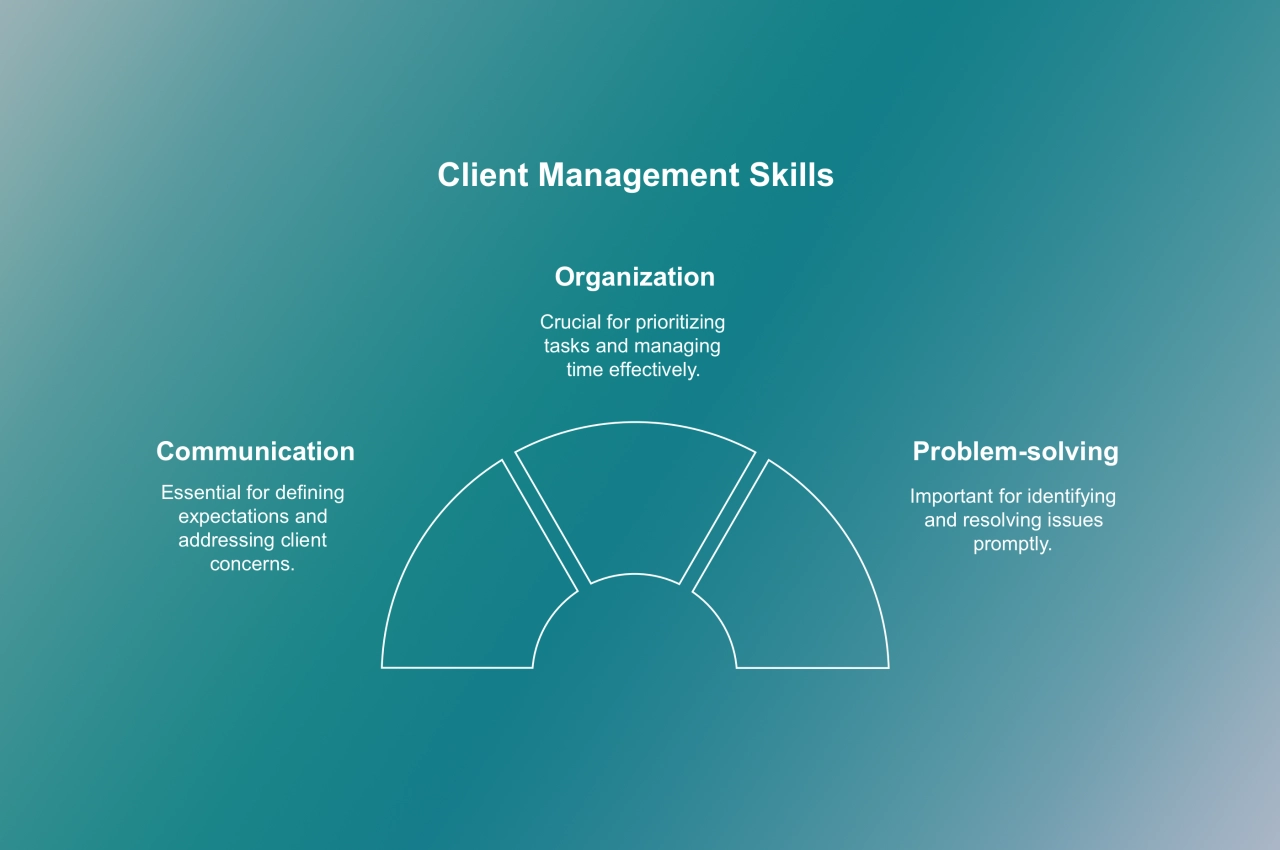
Communication
Effective communication is essential in any business relationship, especially when dealing with clients. This means clearly defining expectations, providing regular project updates, and actively addressing client concerns.
Active listening : Focusing on the client's words and asking questions to understand their needs better.
Clear communication: Clearly outlining service delivery methods, timelines, and milestones.
Organization
Efficiently organizing your time is crucial for managing multiple clients. This includes prioritizing tasks, setting achievable deadlines, and utilizing tools like project management software.
Prioritization : Identifying the most important tasks for each client.
Time management: Allocating adequate time for all tasks required for a successful project.
Problem-solving
Effective problem-solving is vital when managing clients. This entails identifying issues, analyzing their causes, and finding solutions.
Identify problems early on: Detect potential issues before they escalate.
Analyze causes: Examine the root cause of an issue to devise an appropriate solution.
Implement solutions quickly: Efficiently resolve problems as they arise.
How to manage clients in 3 steps
Now that you’re aware of the pitfalls, let’s take a look at how you can manage customers. The good news is that client relationship management is an ongoing process that you have to define and improve upon, depending on the difficulties and discoveries you make. To make things easier, I’ve created three steps for you to follow.
1. Defining roles and responsibilities
To manage your clients effectively, think about assigning a point of contact. Most of our agency clients link their clients up with managers, who are automatically assigned to all orders and tickets. This reduces the need to figure out who is responsible, as the manager will take care of all related tasks.
That being said, a manager might share responsibilities with other team members. Let’s say you’re running a content writing agency. If a delivered blog post was sent back to the client, the manager needs to figure out
what the underlying issue is,
who is responsible for fixing it, and
to assign the task to that person.
Assuming the client wasn’t happy with the blog post, the team member responsible for fixing it could be either the writer, or the editor (depending on the feedback received).
2. Creating a client management strategy
The aforementioned example makes it sound like figuring responsibilities out is an easy task. In reality, it’s much more complicated, depending on the nature of your business activities. To keep your clients happy, create a strategy that includes an actionable step for your team members for every situation they might encounter. You can brainstorm common issues that might creep up, but this will be a long-term project, as you’ll encounter issues you haven’t thought about as your company grows.
If you decide to make use of managers, they need to be aware of their responsibilities, and be able (and allowed to) make decisions when it comes to client requests. This only works if you hire people with great client management skills, and who know the ins and outs of your business operations.
3. Using software to manage clients
While some companies rely on a mix of spreadsheets, Slack and Trello to resolve client pain, at some point, they struggle to stay on top of their work.
The reason is simply, information is spread across multiple tools, which makes it hard to keep track of everything. A better solution is client management software like SPP, where everything is saved in one place. You have CRM fields that can hold information about clients, invoices are saved in the back-end, and your customers can log into the client management system to communicate with you.
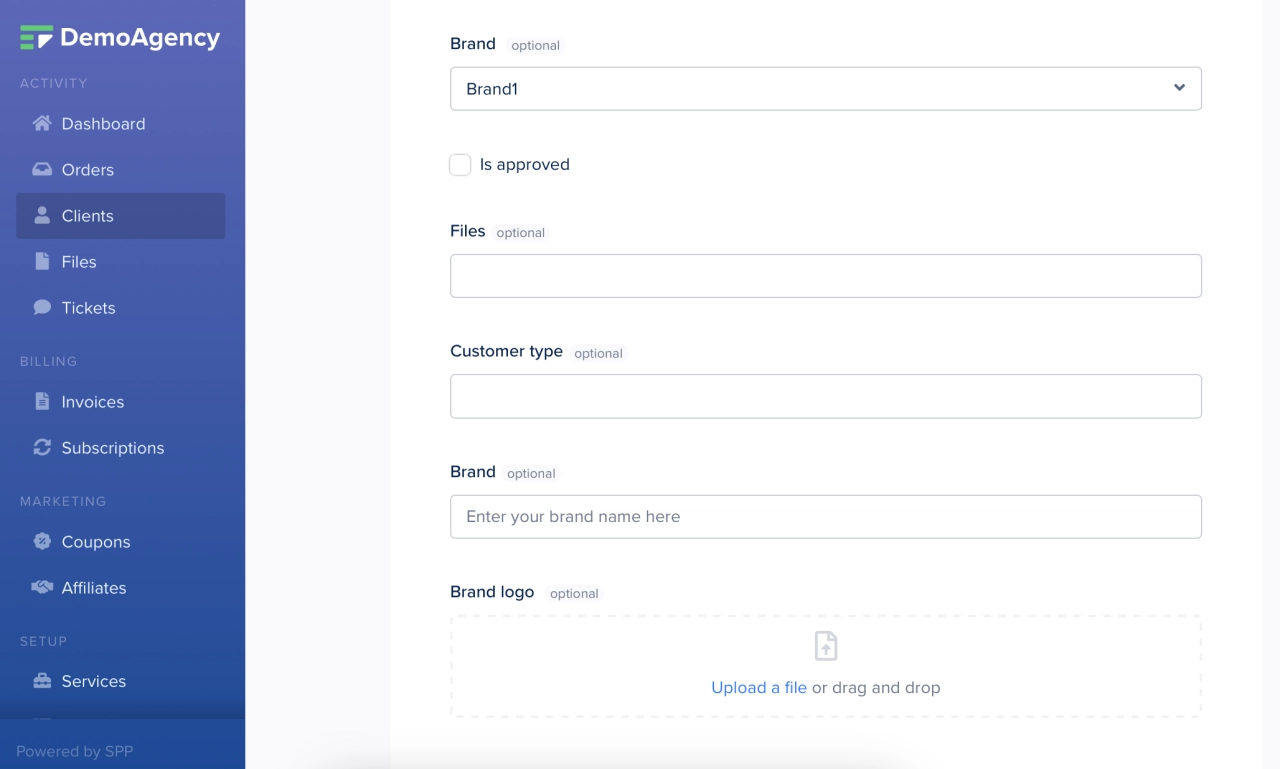
Another added benefit for you, the business owner, is that client management tools usually allow you to work with the saved data. You can export it to your CRM, use webhooks to trigger events, and build automations. Plus, in case of Service Provider Pro, you already have a lot of data about your activities in your dashboard.
SPP works incredibly well for self-service orientated businesses that rely on productization. They can downgrade or upgrade their subscriptions, purchase new services, and fill out intake forms—all without any input from the service provider.
This allows you to focus on what counts, namely delivering the projects. You can still manage clients effectively by customizing the portal, and upsell clients as they purchase new services.
5 client management examples to inspire you
To build trust and improve the relation with your clients, I’ve prepared a few examples below that can help you get started:
Don’t start your project work before you get a general overview of your clients, their goal, and expectations. Survey them with an intake form, and make that information accessible to your team.
Client retention depends on the satisfaction of your customers. You might think they are happy, but are they really? Find out with targeted surveys, which you can even automate.
Client communications should be geared towards their needs, but shouldn’t ignore your own processes. With a client portal such as SPP, customers have the choice of logging into the workspace, but they can also reply via email.
Send your client regular updates about ongoing work, but keep in mind that not everyone needs constant email notifications. Allow them to manage the amount of updates they receive.
Some companies provide client management services to those who don’t have the resources to effectively manage clients on their own. Depending on your needs, this could be support, surveying clients, or doing case studies.
How to manage client work & stay on top of tasks
Relationships are not the only thing that you need to manage. If you want to keep clients, and the revenue they are generating, you should also deliver client work on time, and to their satisfaction.
To accomplish this task, you need to manage client expectations from the beginning. Here are a few questions (you can ask) and possible expectations (from the client):
Why did you choose the service?
Our internal team lacks the knowledge to deliver it.
When do you expect the service to be delivered?
Within the next two weeks.
What is the desired outcome?
That we can focus on other tasks we’re familiar with.
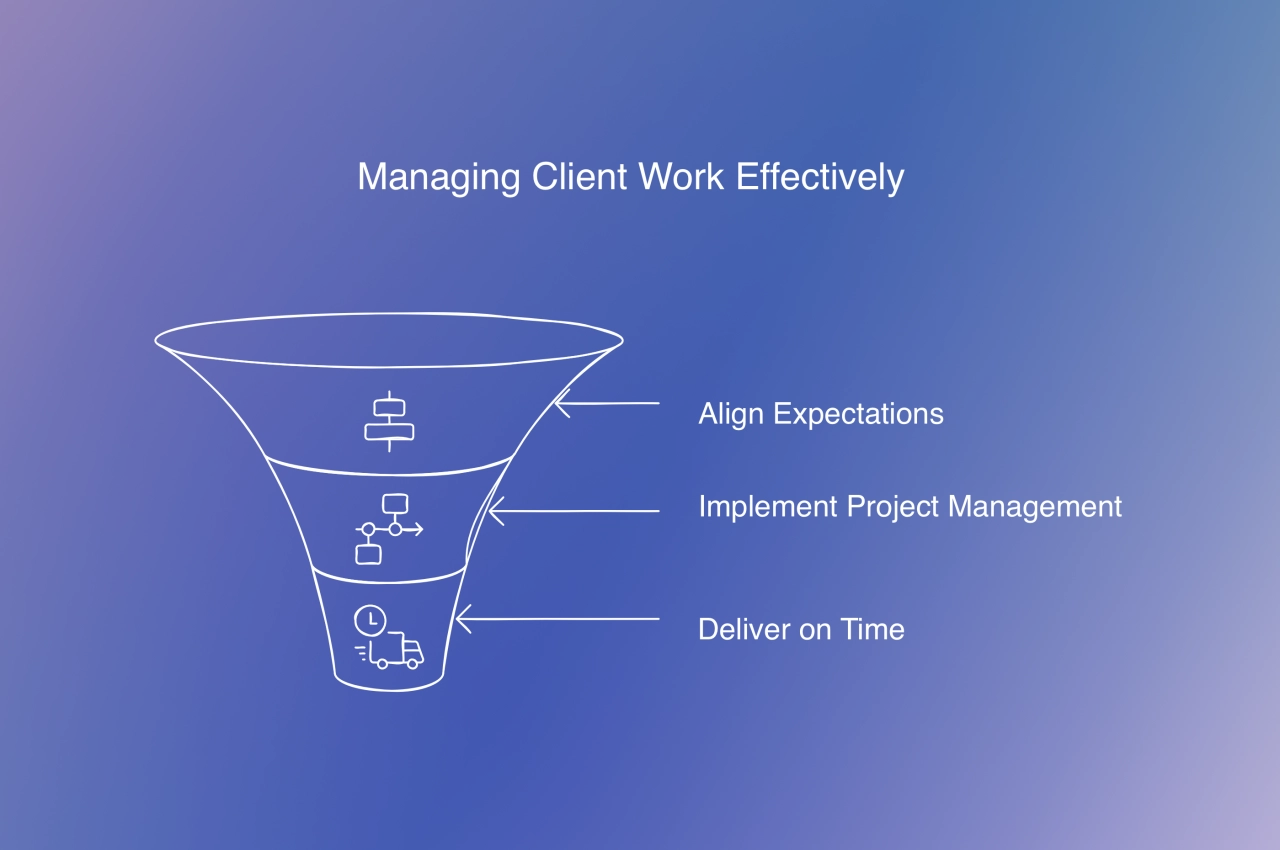
When customers, especially B2B customers, order a service, they are usually looking to outsource tasks; either due to lack of time, or knowledge. If you form a partnership with your clients, you’ll be able to help them grow, and in return, they’re likely to recommend you to their peers.
With the expectations aligned, the only thing left is to think about how you can improve your work management and project delivery. Depending on the niche you’re active in, you can use popular project management tools, or run everything through a client portal solution. The latter has the benefit that it merges multiple functions into one app, from invoicing to project management.
Final thoughts
If you’re looking to manage clients effectively and deliver the best customer experience, you’ll quickly discover how a well-thought-out strategy in combination with modern tools reduce admin tasks while your revenue increases. An added benefit is that a good client relationship might lead to new clients thanks to word-of-mouth referrals. After all, who doesn’t refer a great company to friends and acquaintances?
So, instead of spending money to attract new clients, build existing business relationships, nurture them continuously, and see how you passively attract new clients.




